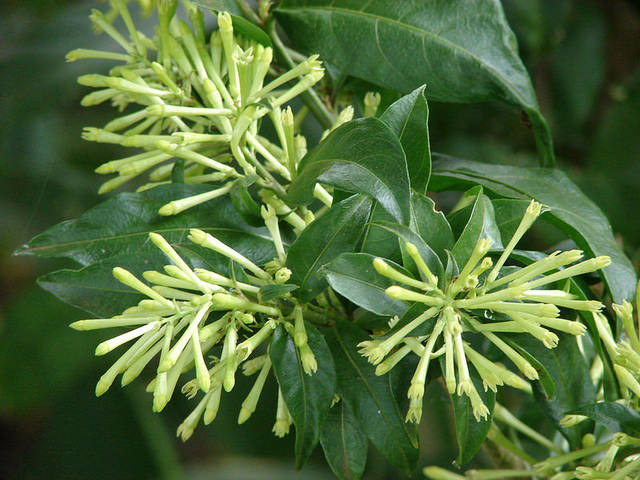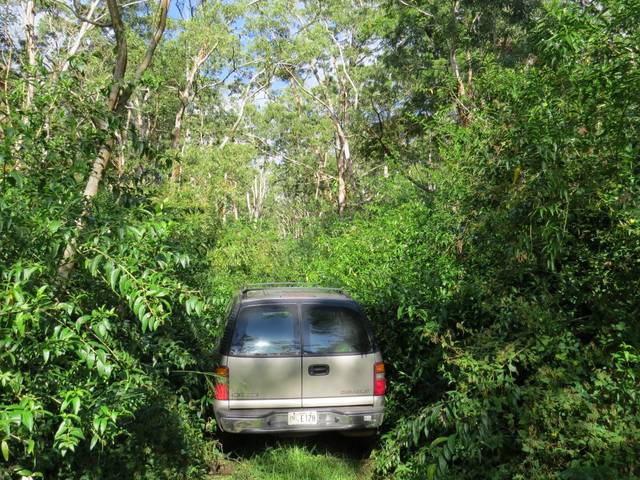Tropical Gardening Helpline: Jasmine’s wrath


Kris asks: I want to grow some night blooming jasmine by my outdoor hot tub. Someone told me it was invasive here and that I shouldn’t plant it. Is that true?
Kris asks: I want to grow some night blooming jasmine by my outdoor hot tub. Someone told me it was invasive here and that I shouldn’t plant it. Is that true?
Tropical Gardener Answer: Yes, I’m sorry to say that is true. Night blooming jasmine is very invasive here and can wreak havoc in native species habitats. The Big Island Invasive Species Council works with a weed risk assessment (WRA) system to determine if a plant is, or might be, invasive based on 49 questions. They have found that night-blooming jasmine (cestrum nocturnum) is highly invasive based on their system.
Several characteristics of this plant make its spread difficult to control. It not only can reproduce vegetatively but its small, white pea-sized fruits are very attractive to birds. Birds consume lots of fruit and often excrete all of the seeds in each berry in upland forests and other native plant habitats. Its rapid growth rate, its tendency to form dense thickets and its ability to thrive in both sun and shade make it additionally invasive. You can find out more about the assessment at https://www.biisc.org/night-blooming-jasmine-2/.
This jasmine has been found growing in native koa forests where it is choking out koa seedlings. On summer evenings when the mauka winds start blowing makai, you can often smell the jasmine growing at upper elevations. This is a clear indication that this plant is well established in the wild.
If you are looking for an alternative, you might want to check out the plant of the month article for May in last week’s paper. The gardenias described there are all fragrant and could perfume the air around your hot tub. The Jasmine sambac oleaceae is also quite fragrant and not invasive here.
If you’d prefer a night blooming alternative, look for lady of the night (Brunfelsia gigantea). This is a highly fragrant South American shrub with white flowers that emit an intoxicating fragrance that intensifies at night. Although it grows slowly, it should begin to bloom within a year. It is not invasive here.
Many plants that are often used in Hawaiian landscapes have been subjected to the weed risk assessment criteria and are known to be invasive here. Some that are well known are being actively controlled by the Invasive Species Councils. They include the albezia tree, banana poka vine, strawberry guava, miconia and kahili ginger. Others that we should remove or avoid planting include the Australian tree fern, the autograph tree, ivy gourd, Christmas berry, all tibouchinas and the Mysore raspberry. Many others are also on the invasive species lists. Check them before you plant.
Here in Hawaii, where native plants thrived for millennia before people, pests or diseases arrived to harm them or their habitats, controlling alien plant and animal species that threaten the native ecosystem requires constant vigilance. Not all non-native plants or animals are invasive, however. Only ones that reproduce quickly, move around easily and can invade native habitats or otherwise cause ecological or economic harm are considered invasive.
Invasive alien species are recognized as one of the leading threats to biodiversity in Hawaii and they impose enormous costs to agriculture, forestry, fisheries, and human enterprises, as well as to human health.
If you want to plant pono and avoid planting a pest, you can find more information on invasive species at any of these websites: https://dlnr.hawaii.gov/hisc/info/invasive-species-profiles/, https://dlnr.hawaii.gov/hisc/info/, https://en.wikipedia.org/wiki/List_of_invasive_plant_species_in_Hawaii.
Email plant questions to konamg@ctahr.hawaii.edu for answers by Certified Master Gardeners. Some questions will be chosen for inclusion in this column.
Diana Duff is a plant adviser, educator and consultant living in a dryland forest north of Kailua-Kona.
Gardening Events
Saturday: “Work Day at Amy Greenwell Garden” from 9 a.m. to 12:30 p.m. Meet at the Garden Visitor Center across from the Manago Hotel in Captain Cook. Volunteers will be able to help with garden maintenance and are invited to bring a brown bag lunch. Water and snacks provided. Call Peter at 323-3318 for more information.
“Vertical Coffee Shoot Selection” from 9-11 a.m. at Lehu’ula Farms, 79-7350 Mamalahoa Highway just makai of the Kona Joe sign in Kainaliu with Bob Nelson and Bob Smith. Learn how to choose the best verticals to save for maximum production. Free to KCFA members/$10 (applied toward membership) for non-members. For more information go to https://www.konacoffeefarmers.org/kcfa-business/newsletters/may-2018-the-independent-voice/.
Farmer Direct Markets
Wednesday: “Hooulu Farmers Market” 9 a.m. to 2 p.m. at Sheraton Kona Resort &Spa at Keauhou Bay
“Sunset Farmers Market” 2-6 p.m. in the HPM parking lot at 74-5511 Luhia Street in Kailua-Kona (across from Target)
Friday: “Pure Kona Market” 9 a.m. to 5 p.m. at Amy Greenwell Garden in Captain Cook
Saturday: “Keauhou Farmers Market” 8 a.m. to noon at Keauhou Shopping Center
“Kamuela Farmer’s Market” from 7 a.m. to noon at Pukalani Stables
“Waimea Town Market” from 7:30 a.m. to noon at the Parker School in central Waimea
“Waimea Homestead Farmers Market” from 7 a.m. to noon at the Waimea Middle andElementary School Playground
Sunday: “Pure Kona Green Market” 9 a.m. to 2 p.m. at Amy Greenwell Garden in Captain Cook
“Hamakua Harvest” 9 a.m. to 2 p.m. at Hwy 19 and Mamane Street in Honoka’a.
Plant Advice Lines
Anytime: konamg@ctahr.hawaii.edu
Tuesdays &Thursdays: 9 a.m. to noon at UH-CES in Kainaliu – 322-4893
Mondays &Fridays: 9 a.m. to noon at UH CES at Komohana in Hilo 981-5199 or himga@hawaii.edu


